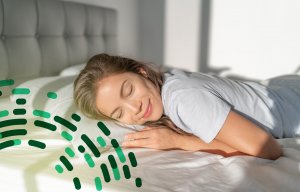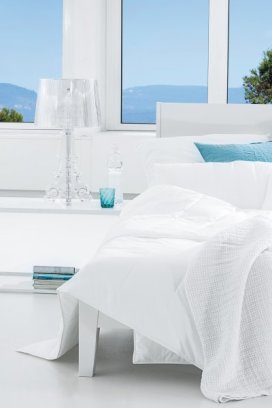
Probiotic colonisation with Allergen Tech
Hohenstein and Centa-Star develop special bedding for dust mite allergy sufferers.

13th July 2017
Innovation in Textiles
|
Bönnigheim
“At the WKI we had been closely studying the question of how odour molecules (such as sweat odour) could be bound to fibres and how they could then be released from the fibres again. Precisely this binding of the molecules to the fibres is an effective way of keeping the odours away from your nose. So we hit upon the idea of applying the same principle to allergens,” said Dr Hammer, from Hohenstein.
“The researchers at the Hohenstein Institute found out that allergens have a positive charge. So we jointly came up with the idea of developing a product for allergy sufferers which would make use of the physical principle of magnetic attraction – instead of the heavy-duty encasings and biocides that had been used until then,” explained Thomas Müller, Centa-Star.
Between 10 and 15% of the population are allergic to dust mites, and the number of people affected is rising year after year. The symptoms often have a very detrimental effect on everyday lives, so taking preventive measures is important. For allergy sufferers, the most important preventive measure they can take is to keep allergens away from their respiratory organs – especially in the bedroom.
One of the main areas of work at the Hohenstein Group's William Küster Institute for Hygiene, Environment and Medicine (WKI) is researching the compatibility of textiles for users, and this includes the management of allergens. Hohenstein spotted the potential of textile-based allergy prevention and worked closely with the industry to find a solution: over months of fundamental research, and multiple optimisation stages, Hohenstein developed a negatively-charged textile finish which attracts the positively-charged allergens like a magnet.
The new AllergoProtect aims to provide that allergens are not breathed in and no longer cause allergic reactions. During washing, the allergens bound to the fibres are removed from the filling of the bedding, and the physical binding function of the textile is regenerated – and remains fully effective even after 10 washes at 60°C in a domestic washing machine using heavy duty detergent followed by tumble drying, the institute reports.
AllergoProtect is also certified under the Standard 100 by Oeko-Tex Class I – the Standard 100 product class that has the strictest specifications for human ecology.
“The binding of the allergens needed to be very effective. But at the same time, the effect had to be reversible, because it had to be possible to remove the allergens by washing in the washing machine. And, of course, the materials that were used needed, themselves, to be skin-friendly and non-allergenic and proven in countless tests and trials with volunteers. At the end of this long process, the products were successfully awarded the Seal of Quality and certified under Standard 100 by Oeko-Tex. Last but not least, marketing this new product in an easily understandable way was also quite a challenge,” commented Thomas Müller, Centa-Star.
The endurance testing for AllergoProtect was carried out by the European Centre for Allergy Research Foundation and it has been awarded the ECARF Seal of Quality. In trials with volunteers, the effectiveness of AllergoProtect was demonstrated. Now AllergoProtect is protected by a registered patent and after just a short time is already in great demand in the retail business, according to the institute.

Business intelligence for the fibre, textiles and apparel industries: technologies, innovations, markets, investments, trade policy, sourcing, strategy...
Find out more